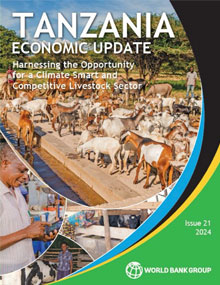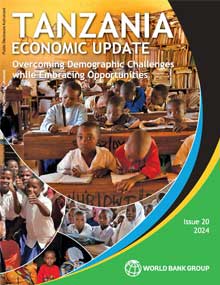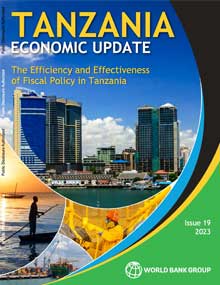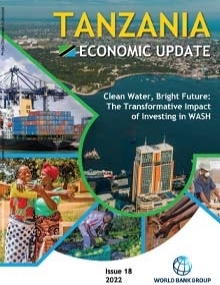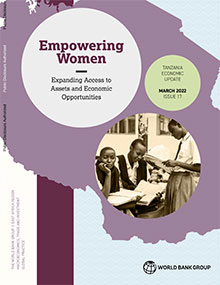Tanzania Economic Update (TEU)
Harnessing the Opportunity for a Climate Smart and Competitiveness Livestock Sector in Tanzania
The special topic of the 21st Tanzania Economic Update ‘Harnessing the Opportunity for a Climate-Smart and Competitive Livestock Sector in Tanzania.’ It discusses how Tanzania can boost its livestock sector's economic contribution with a bold and comprehensive plan that emphasizes climate-smart strategies and innovations. While the country boasts a large livestock population, climate-related risks and inadequate investment from the public and private sectors impede sectoral growth and international competitiveness. Nevertheless, with increasing domestic demand and a burgeoning need for livestock products, there is an opportunity to capitalize on this internal market while simultaneously exploring avenues for expanding exports.
Overcoming Demographic Challenges while Embracing Opportunities
The 20th TEU titled, ‘Overcoming Demographic Challenges while Embracing Opportunities’, shows that while Tanzania has seen a rapid drop in infant and child mortality over several decades, there has been only a minimal decline in fertility. As a result, the population growth rate remains high, at three percent. At this rate, the population will double in 23 years, increasing demand for social services outstripping the economy's capacity to provide essential services, such as health and education, and create jobs.
Global growth is projected to slow significantly in 2023 as continued monetary tightening constrains the credit supply. Tanzania’s economy has performed relatively well despite a challenging external environment. The government recognizes that a dynamic private sector fueled both by domestic and international investment is crucial to increase productivity, accelerate job creation, and support more inclusive and resilient growth. Tanzania has several macroeconomic advantages that could support a successful transition to middle-income status. Tanzania’s most urgent reform priorities include measures to improve efficiency and effectiveness of expenditure programs and boost tax-revenue mobilization. The government should assess and regulate budget transfers to state-owned enterprises to ensure their sustainability. An analysis of the implementation capacity of ministries with low expenditure execution rates could inform efforts to improve procurement systems and strengthen monitoring and evaluation. The government should adjust VAT, corporate income tax, and excise tax rates to increase revenue mobilization, and excise taxes on tobacco should be reevaluated to balance revenue and public health objectives. Strengthening taxation on wealthier households is vital to improve the equity of the tax system. Reinforcing the tax administration’s auditing capacity will be necessary to boost collection efficiency and enhance distributional equity, and registration thresholds should also be adjusted to broaden the tax base. The Commitment to Equity (CEQ) methodology could be used to assess the impact of proposed fiscal policy changes on household income, poverty, and inequality.
Tanzania Economic Update 18: Clean Water, Bright Future: The Transformative Impact of Investing in WASH
This edition of the report shows that while the country has made significant progress in recent years in providing universal access to water supply, sanitation, and hygiene (WASH), only 61 percent of households have access to basic water supply, 32 percent to basic sanitation, and 48 percent to basic hygiene (per the Sustainable Development Goals’ definitions). More than nine percent of the population continues to practice open defecation which entails serious health risks. In addition, rural areas lag behind urban centers in all dimensions of WASH.
Tanzania Economic Update 17 Final Report : Empowering Women - Expanding Access to Assets and Economic Opportunities
This edition of the Tanzania Economic Update includes a special focus section on women’s economic empowerment, which will play a pivotal role in achieving an inclusive and resilient post-crisis recovery. Tanzania has experienced over 20 years of sustained economic growth, culminating in its transition from low-income to lower-middle-income status in July 2020. Between 2007 and 2018, the national poverty rate fell from 34.4 to 26.4 percent, while the extreme poverty rate dropped from 12 to 8 percent. The Tanzania Development Vision 2025, which aims to enable the country to achieve middle-income status within the next three years, emphasizes gender equity in its social, economic, and political dimensions.
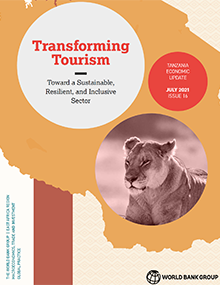
Transforming Tourism: Toward a Sustainable, Resilient, and Inclusive Sector
The latest Tanzania Economic Update highlights the huge untapped potential of the tourism sector to drive the country’s development agenda. The new analysis discusses long-standing issues facing tourism in Tanzania as well as new challenges brought on by the COVID-19 pandemic. The report says that the pandemic offers an opportunity for policy actions for the sector to recover in the near term and become a sustainable engine of private-sector-driven growth, social and economic inclusion, and climate adaptation and mitigation over the long term.
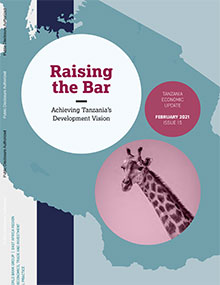
Raising the Bar - Achieving Tanzania’s Development Vision
The emergency of the COVID-19 novel coronavirus plunged the global economy into a recession in 2020, and the pace of recovery remains uncertain both among advanced and emerging economies. Pandemic-related health restrictions and the adoption of precautionary behaviors by firms and consumers have greatly slowed economic activity, while uncertainty regarding the post-pandemic economic landscape and key policy decisions have discouraged investment. Agricultural and manufacturing firms face serious questions regarding the viability of global value chains, and the unforeseeable course of the pandemic weighs on international trade and tourism (World Bank 2021). Meanwhile, the disease itself continues to exact an enormous and mounting toll on human lives, and the disruption of education systems has slowed human capital accumulation, which could negatively impact the productivity of an entire generation. The global economy contracted by an estimated 4.3 percent in 2020, and while a 3.8 percent rebound is projected for 2021, worldwide economic output is expected to remain well below prepandemic trends over the near term.
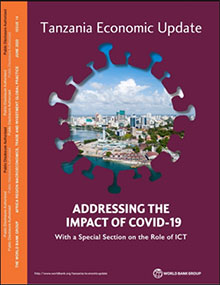
Addressing the Impact of COVID-19. With a Special Section on the Role of ICT
State of the economy: In 2019 growth in Tanzania’s economy was again solid, but this year COVID-19is expected to cut GDP growth at least in half and increase poverty. Growth slowdown in Tanzania’s main trade partners has reduced demand and prices for its agricultural commodities and final manufactured goods, and international travel bans and fear of contracting the virus are expected to inhibit the recovery of tourism, which has been one of the fastest-growing sectors in the economy. Domestic business conditions are expected to deteriorate. The current outlook is highly uncertain, and risks are tilted to the downside especially if global demand remains suppressed or government actions are not strong, well-targeted or sustained. The risks for a more negative growth outlook than the baseline described above are high. Under a severe local outbreak, Tanzania’s health care system would become heavily strained, and self-imposed social distancing could dampen much of the economy. This would likely lead to a delayed economic recovery, and Tanzania would face continued pressures to finance additional health spending to save lives and provide support to protect livelihoods. Even if the outbreak is contained in Tanzania, a protracted/resurging global health crisis that continues in 2021 could undermine global demand, and thus, the Tanzanian economy. Furthermore, even if the global health crisis is contained and Tanzania’s COVID-19 reported cases also decrease, additional trade and logistics restrictions could continue disrupting global trade during the recovery. Tanzania’s macroeconomic performance has been strong for the last decade, but the current crisis is an unprecedented shock that requires strong, well-targeted and sustained policy response.
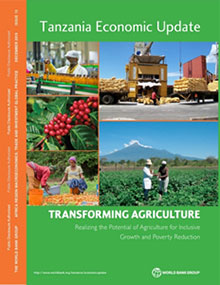
Transforming Agriculture - Realizing the Potential of Agriculture for Inclusive Growth and Poverty Reduction
Tanzania was again one of the top growth performers in the region. Official GDP figures show that growth remained steady in the first half of the year, driven by higher public investment and by a recovery in exports. Inflation has been low and stable, and the balance of payments is quite sound despite a widening current account deficit. Exports are recovering from last year’s contraction. The Government's Tanzania Development Vision 2025 and the Five-Year Development Plan (FYDP II) set out ambitious goals for reducing poverty and sustainably industrializing so that the country can achieve middle-income status by 2025. The government recognizes agriculture as central to realizing its objectives of socioeconomic development, which are well-articulated in the Second Agriculture Sector Development Program (ASDP II). Among the goals of ASDP II are to transform agriculture by promoting commercialization, prioritizing high-potential commodity value chains, and mobilizing capital by giving the formal private sector a growing role in agriculture. Because agriculture and related value chains drive two-thirds of all jobs—three-quarters for the poor— the sector is central to creating more and better jobs at scale and significantly reducing poverty.
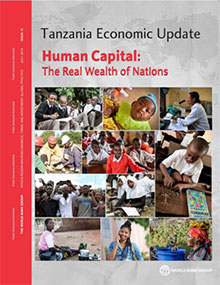
Human Capital: The Real Wealth of Nations
Investing in human capital is essential for Tanzania. To generate future income and achieve sustainable development, people are the most important asset countries have. Part two of this economic update discusses where Tanzania stands in terms of its investments in human capital for both children and adults. The analysis is part of the World Bank Human Capital Project (HCP), which relies on both the Human Capital Index (HCI) and data on human capital wealth (HCW).
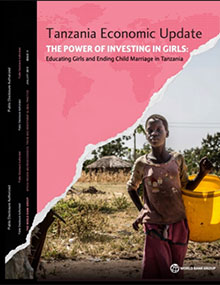
The Power of Investing in Girls - Educating Girls and Ending Child Marriage in Tanzania
Economic performance in 2018 has been mixed. The data that are available suggest some areas of softening in the economy.1 Foreign direct investment declined to 2 percent of GDP in 2017, down from about 5 percent in 2014. The current account deficit has increased to 3.8 percent of GDP in the year ending September 2018, from 2.2 in the preceding 12 months. Recent Bank of Tanzania data confirm lower cashew exports and 2017 decline in non-traditional exports has continued into 2018, which raises concerns on prospects for longer term growth. The Tanzania Revenue Authority is reporting that many large tax payers are unable to meet their tax obligations on time. Nonperforming loans have declined recently to 9.7 percent in September 2018 from 12.5 percent in September 2017, but remain almost double the 5 percent statutory threshold. Banks have limited lending to businesses and interest rates are high (18 percent for one-year loans in August 2018), though some banks have lowered benchmark lending rates. On a positive note, credit to the private sector has been edging up, reaching 4.9 percent in the 12 months ending September 2018. The fiscal deficit is still low, not counting payment arrears and delayed refunds of value-added tax. The 2017/18 budget deficit after grants of 1.3 percent of GDP suggests effective spending management but does not factor in payment arrears, with an estimated stock of over 3 percent of GDP. Government is paying down roughly TZS 1 trillion of verified arrears per fiscal year. The low deficit is the result of controlled recurrent expenditures and under execution of the development budget by more than 40 percent. Contributing factors include shortfalls in domestic revenue and external financing for large projects. Public debt is currently sustainable, but there is need for the Government to consider cost-effective financing options and manage associated risks to support public investments. The 2018/19 budget targets public investment to consume 45 percent of total spending, equivalent to 9.1 percent of GDP compared to 5.5 a year prior.
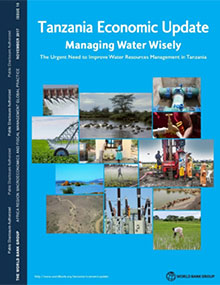
Managing Water Wisely - The Urgent Need to Improve Water Resources Management in Tanzania Public
The tenth edition of the Tanzania Economic Update covers the state of the economy and includes a near term outlook, with a special focus chapter on one of the most cross-cutting determinants of development outcomes, water resource management. Part One presents a discussion and analysis of Tanzania's recent macroeconomic and fiscal performance, with an updated outlook for the near term. Part Two presents an analysis of Tanzania's management of its water resources, showing that the management of these resources has massive implications for Tanzania's people, its economy and its environment, and that there is an urgent need for improvements.
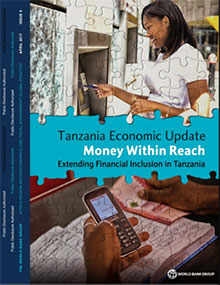
Money within Reach - Extending Financial Inclusion in Tanzania
In 2016, the global economic environment remained subdued, with growth performance in Sub-Saharan Africa the weakest in over 20 years. Economic conditions across most advanced economies remained challenging, while emerging and developing economies as a whole are set to maintain their growth momentum. However, there is a lot of variation between developing countries. Growth in Sub-Saharan Africa slowed down significantly, dropping from an average real GDP growth rate of 4.5 percent in the 2010-15 period to an estimated 1.5 percent in 2016, the lowest rate in more than two decades. The decline in the region's average growth rate is the result of a number of factors, most notably the ongoing adjustments to sluggish commodity prices, the slowdown in export demand, and the tightening of global financial conditions. In the context of these developments, the ninth edition of the Tanzania Economic Update describes the current state of the economy, with the special topic focusing on financial inclusion. The report aims to stimulate policy analysis and debate around the key economic and development challenges that Tanzania faces as it strives to fulfill its aspirations of becoming a middle-income country. In addition to describing key aspects of macroeconomic performance and fiscal management, the report presents a timely analysis of the impact of financial sector deepening on economic activity and on the livelihoods of Tanzanians.
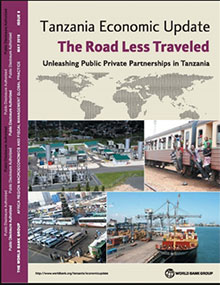
The road less traveled – unleashing public private partnerships in Tanzania
The Tanzanian economy has grown at an average annual rate of around 6-7 percent for more than a decade. The rate of inflation has declined since January 2016, although it trended upwards in the preceding few months due to increases in domestic food prices and the lagged impacts of the sharp depreciation of the Tanzanian Shilling during the first half of 2015. However, the Shilling stabilized in the second half of 2015, with the real exchange rate now close to the equilibrium level. The current account deficit has also improved, standing at around 8.7 percent of GDP in 2014/15. The level of aid inflows declined during 2014/15, although this was offset by increases in FDI and external non-concessional borrowing, maintaining the overall balance of payments in a stable position. Tanzania's infrastructure and social services deficits are already massive and projected to increase into the future. Traditional financing instruments are clearly insufficient to bridge the profound gap between existing public resources and financing requirements. By leveraging synergy between the public and private sectors, PPPs can mobilize additional sources of finance to fund the development of vitally needed infrastructure; to deliver on budget and on time to a greater extent than in the case of publicly financed projects; and to deliver higher quality services than in the case of publicly managed projects. Tanzania’s own policy documents identify PPP as a key instrument to attract new investment and to deliver infrastructure more efficiently.
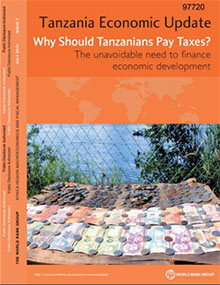
Why should Tanzanians pay taxes? The unavoidable need to finance economic development
This seventh economic update goes to the heart of one of the main challenges faced by Tanzania: how can the country finance its development? This is a fundamental question when aid is coming down as a proportion of a growing GDP, and as access to financial markets remains limited. One option would be to rely more on the private sector to deliver education, health, roads, ports and electricity. This is possible as demonstrated by many such experiences around the world, and therefore this approach needs to be one important part of the solution to finance development. The argument presented in this economic update is that higher tax revenues will come only if a comprehensive approach is adopted. The tax system has to be affordable, fair, simple, and transparent. The government also has to be accountable for the money it is receiving. It is only when these basic conditions are met that tax compliance will increase. Because a strong social contract between the State and its citizens is not yet sufficiently in place in Tanzania, a number of suggestions are proposed in the update, with the objective of stimulating debate on possible approaches to increase tax revenue.
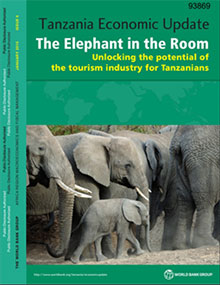
The Elephant in the Room: Unlocking the Potential of the Tourism Industry for Tanzanians
The focus of this economic update is the tourism sector, which is clearly central to Tanzania s drive toward economic emergence. Riding on the country s bountiful natural assets, tourism is a fast growing sector that is not only providing jobs but is also bringing in much-needed foreign currency. This sector already benefits from substantial attention from the country s leadership, notably in the context of the national business council that recently prioritized tourism as a high growth industry and a major source of job creation. Nevertheless, more can be done to increase benefits so they can be felt more broadly across society. This update proposes three strategic directions towards achieving this goal: (i) the diversification of tourism activities, in multiple dimensions; (ii) further integration in to the sector of stakeholders such as local communities and small operators; and (iii) good governance in the management of fiscal revenues as well as in the use of natural assets. This update also assesses the current state of the Tanzanian economy. While recent developments remain globally positive with high and stable GDP growth and with the inflation rate currently in check, fiscal risks for Tanzania have been growing. During the last fiscal year, the Government missed its revenue targets and was forced to cut priority expenditures and accumulate arrears with contractors and pension funds.
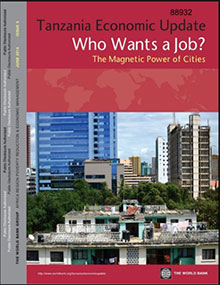
Who Wants a Job? The magnetic power of cities
This fifth economic update also examines prospects for economic prosperity in the context of rapid urbanization; in particular, how the growth of cities can be harnessed to create productive jobs for a labor force that is expected to double in the next 15 years. By 2030, Dar es Salaam will be a mega city of over 10 million people. As demonstrated by many countries in the world, cities encourage the creation and expansion of businesses by reducing distances between suppliers and customers. Can Dar es Salaam and other Tanzanian urban areas become thriving cities? Can they avoid becoming metropolis slums? Urbanization comes with significant challenges, notably in terms of increased pressure on infrastructure, housing, and service provision. The quality of the business climate in urban Tanzania will need to be improved, as most small and large entrepreneurs suffer from the uncertainty, corruption, and insecurity that characterize the business environment. This economic update argues that these challenges need to be addressed with a sense of urgency.
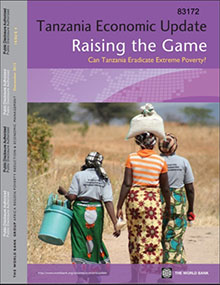
Raising the game - can Tanzania eradicate extreme poverty?
The special focus of this fourth economic update is as much a concern for policymakers as for ordinary citizens. This economic update discusses a bold new way of lessening extreme poverty by transferring cash directly to the most vulnerable people. In Tanzania, the success of a similar program piloted by the Tanzania Social Action Fund (TASAF), which includes conditional cash transfers as well as public works for productive infrastructure, is also very encouraging as shown by an independent evaluation. Although cash transfers are promising, as this update discusses, there are risks associated with implementation on a large scale. It will be essential to ensure effective targeting and sound monitoring. And the decision to scale up needs to be embedded in strategic thinking about medium-term fiscal sustainability. The economic update also discusses the state of the economy more broadly. Strong and stable economic growth and gradually declining inflation have been the hallmarks of Tanzania's recent economic performance. Tanzania needs to strike the right balance between making large capital investments and maintaining fiscal discipline. Tanzania needs to maintain fiscal discipline and continue to keep the country's debt and debt-service at acceptable levels to consolidate the gains achieved over the past decade. In this context, the report is organized in two parts: part one is the state of the economy; and part two is money to people: can conditional cash transfers make a difference?
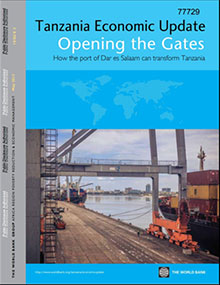
Opening the gates: how the port of Dar es Salaam can transform Tanzania
The wide media coverage of the series as well as the interest in the blog show that the debate has been gradually moving from ministerial corridors to the public arena. This latest update foresees that the Tanzanian economy will maintain its resilience by continuing to grow at about 7 percent in the coming years. If some clouds are looming on the external and fiscal horizons, the update argues that the risks they pose should be manageable. The majority of the country’s top 100 mid-size enterprises believe that 2013 will be better than 2012; and 2014 better than 2013. Nevertheless, a growing consensus today is that Tanzania needs to rely more than today on private enterprises to achieve faster and more equitable growth, as private enterprises are the ones that can provide jobs, build infrastructure, and bring new technology to the local economy. Many actions are needed on the policy front, especially to improve the business environment. Tanzania has gradually opened its economy since the early 2000s; it is also true that business coming in and going out of the country remains costly. To reduce trade costs, the priority should be to transform the Port of Dar es Salaam. An efficient port is critical because approximately 90 percent of Tanzania’s international trade goes through its gates. This is a welcome development for local and regional consumers and firms that heavily depend on the performance of the port in their daily endeavors.
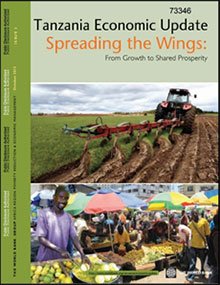
Spreading the Wings: From Economic Growth to Shared Prosperity
Tanzania continues to stand out as a model of sound economic performance in the African continent, with a growth rate of over six per cent in 2011 and 2012, surpassing other regional economies and demonstrating impressive resilience to the global economic crisis. This is the second issue of the Tanzania economic update series. The series aim to engage a broad audience in a discussion of the state of the economy in general, as well as in specific debates of topical importance in Tanzania. The current issue seeks to get the discussion going on how to achieve the structural transformation of the rural economy so that rural households can also benefit from the country's remarkable growth performance.
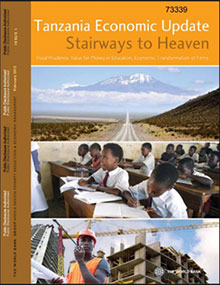
Stairways to Heaven: Fiscal Prudence, Value for Money in Education, and Economic Transformation of Firms
Tanzania's Gross Domestic Product (GDP) growth in the last 12 years has been extremely strong, averaging close to 7 percent annually. This rate is high, but still lower than that of successful emerging countries when the nation's high population growth rate of about 3 percent is factored into the equation. Economic growth has failed to eradicate poverty, with one third of households still living below the poverty line. If Tanzania aims to reduce the income gap between itself and middle-income countries, it will have to grow faster and better. This Tanzania economic update focuses on the need to transform the education system and to foster growth amongst business enterprises. These are the two vital elements by which Tanzania will achieve accelerated and shared growth. There is a synergistic effect between these two elements, since better educated people are more productive and therefore play a major role in making business enterprises become more competitive. The reverse is also true, since more competitive business enterprises can invest more in human capital. Those synergies are at the heart of economic development.
